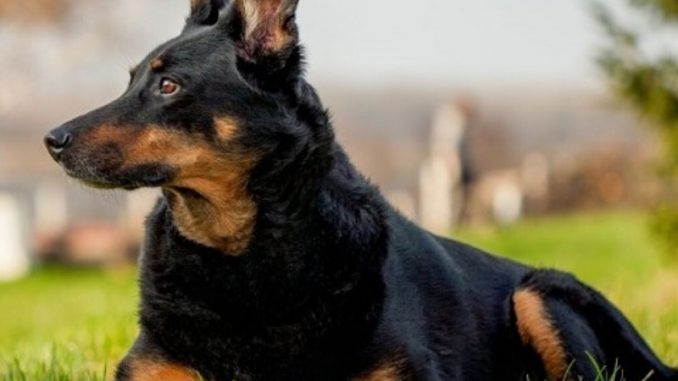
I’ve always been intrigued by the German Shepherd Doberman Mix, which is a cross between a German Shepherd and a Doberman Pinscher.
This hybrid, also known as the Doberman Shepherd, combines the best traits of both parent breeds. German Shepherds are known for their intelligence and loyalty, while Dobermans are recognized for their strength and alertness. The mix results in a dog that is both smart and protective.
I love their high energy level. They’re usually very trainable, responding well to consistent and positive training methods. But, you have to socialize them from a young age, as they can be reserved with strangers, inheriting the German Shepherd’s cautious nature and the Doberman’s watchfulness.
In the rest of the article, I plan to tell you about their health and temperament, the importance of training and socialization, and how to care for them. I’ll also share insights on their diet and exercise needs.
TABLE OF CONTENTS
- German Shepherd Doberman Mix Quick Summary
- Doberman Shepherd Parent Breeds
- Doberman German Shepherd Mix Physical Characteristics
- Doberman Shepherd Mix Personality and Temperament
- Doberman and German Shepherd Mix Care Guide
- Doberman German Shepherd Mix Health Issues
- German Shepherd Doberman Mix Cost
- Should You Get a Doberman German Shepherd Mix?
- FAQs on Doberman German Shepherd Mix
- A Loyal, Intelligent, and Energetic Hybrid
German Shepherd Doberman Mix Quick Summary
Doberman Shepherd Parent Breeds

The Doberman Shepherd is a new type of crossbreed. It was introduced in the 1990s, although its exact origins are unknown.
The breed comes from mixing a purebred Doberman and a purebred German Shepherd. It doesn’t matter which breed is the mother or father. A Doberman Shepherd is the result of any German Shepherd and Doberman mix.
To understand the German Shepherd Doberman Mix, it helps to understand the origins of its two parent breeds. Below is a brief rundown of the two parent breeds.
German Shepherd
Origin
German Shepherds, a breed that has always fascinated me, were originally bred to herd sheep. Their origins trace back to the 1880s in Germany. It was Captain Max von Stephanitz who transformed this breed into the iconic German Shepherd we recognize today. His vision was to develop a dog that excelled in both intelligence and working ability, and indeed, he succeeded remarkably.
Physical Characteristics
When I think of a German Shepherd, the first image that comes to mind is their distinctive, powerful build. They have a muscular frame, a bushy tail, and ears that stand erect, always alert. Their coat, which can be either short or long, comes in various colors, though the most common are tan with black markings. German Shepherds are large dogs, with males typically weighing between 65 to 90 pounds and females slightly smaller.
Temperament and Behavior
One of the most endearing qualities of German Shepherds is their loyal, protective personality. This trait is often passed on to the Doberman Shepherd mix. A German Shepherd dominant mix will usually have less aggressive tendencies than a Doberman dominant mix. I’ve always admired their versatility – they are not only loyal family pets but also excel in roles such as police, service, or therapy dogs. They possess a high level of intelligence, which makes them highly trainable. However, they need proper socialization and training from a young age to manage their protective instincts effectively.
Doberman
Origin
The Doberman, another breed that I hold in high regard, originated in Germany at the start of the 20th century. Karl Friedrich Louis Dobermann, a tax collector, created this breed. His goal was to have a medium-sized guard and companion dog that would also offer protection during his tax collection rounds. The resulting breed, named after him, stands as a testament to his vision, combining both strength and loyalty.
Physical Characteristics
Dobermans are known for their sleek, athletic build. They have a smooth coat, usually in colors of black, red, blue, or fawn, with rust markings. These dogs are muscular yet elegant, with a proud posture that commands attention. Males typically weigh between 75 to 100 pounds, and females are slightly lighter. Their ears, when cropped, stand erect, adding to their alert appearance.
Temperament and Behavior
The Doberman is renowned for its docile, protective, and intelligent personality. These traits are certainly passed onto the Doberman Shepherd. In my observations, Dobermans tend to be more sensitive than German Shepherds. A Doberman dominant mix in the Doberman Shepherd will likely have a laid-back, sensitive side. This sensitivity means they respond well to positive reinforcement in training. They are fiercely loyal and protective of their families, making them excellent guard dogs. However, this protective nature should be balanced with proper socialization to ensure they are well-adjusted.
Doberman German Shepherd Mix Physical Characteristics
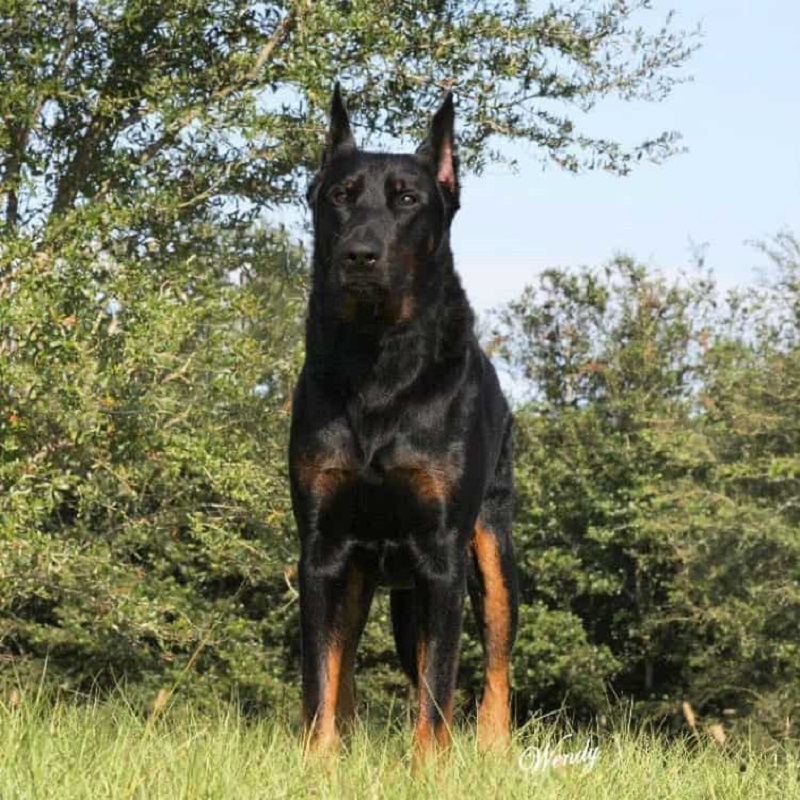
The German Shepherd Doberman mix has an agile and muscular appearance. It has a soft coat that can be a variation of black, tan, and brown. Its muzzle is dignified and long, while the ears stand tall and alert.
Size and Weight
When fully grown, they stand impressively at 22 to 26 inches tall. I’ve noticed that females tend to be a bit shorter than males, but both genders typically weigh between 90 and 110 pounds, showcasing a robust and muscular build.
One distinct feature I’ve observed in the German Shepherd Doberman Mix, compared to purebred Dobermans, is their slightly longer body. This gives them a unique and striking appearance. Their eyes are invariably a deep, expressive brown, reflecting their keen intelligence and alertness. The nose is always black, standing out against their varied coat colors.
It’s fascinating to see the rapid growth of Doberman Shepherd puppies. At six weeks old, they weigh between 8 and 12 pounds, already showing signs of their future strength and size. By the time they reach 18 months of age, they are considered fully grown.
Coat
They typically have a medium-length coat, but the length can vary, sometimes leaning more towards the Doberman’s sleekness or the German Shepherd’s fuller coat. What’s fascinating is the Doberman Shepherd’s single-layered coat, a contrast to the German Shepherd’s double-layered one. The puppies can have either a single or double coat, adding to the uniqueness of each pup.
In terms of color, the Doberman Shepherd’s coat is a beautiful blend of black, tan, and brown hues. This combination is a direct reflection of their parentage – German Shepherds are always black and tan, which contributes to the mix’s base color. Dobermans, on the other hand, can be black and tan or brown and tan, influencing the potential variety in the Doberman Shepherd’s coat colors. Each time I encounter a Doberman Shepherd, I’m struck by the diversity in their coat patterns and colors, making each one of them distinctively charming.
Ears
The Doberman Shepherd may have ears that stand up or flop down. Dobermans have ears that naturally flop down, while the ears of a German Shepherd stand up. Hence, the ears of the Doberman Shepherd will depend on whether they have a German Shepherd or Doberman dominant mix.
Tail
Doberman Shepherds have long tails. The German Shepherd and Doberman breeds have naturally long tails. Dobermans can have their tails docked, but they are not naturally short.
Stance
German Shepherds and Dobermans have a sloping stance. This is passed down to the Doberman Shepherd. As such, they stand tall, alert, and ready to move.
Doberman Shepherd Mix Personality and Temperament

The Doberman Shepherd’s personality and temperament are aspects I’ve always found intriguing. They exude confidence and possess a playful, energetic spirit. However, their strong guarding instinct is something that can’t be overlooked, as it can manifest as signs of aggression. This breed needs a firm, confident, and experienced owner who can provide the right balance of guidance and affection.
I’ve seen firsthand how the Doberman Shepherd forms deep bonds with their owners. They have a loyal nature and often exhibit ‘velcro’ behavior, preferring to stay close to their human companions. This trait also means they can struggle with separation anxiety, finding it hard to be alone for long periods.
Their high energy levels are another characteristic trait. The Doberman Shepherd requires ample exercise and mental stimulation to stay happy and well-behaved. Without this, they may resort to disruptive behaviors like excessive barking or chewing.
Doberman Shepherds and Children
While the Doberman Shepherd can be a fantastic family pet, supervision around children is essential. Their size and strength, combined with their energetic nature, mean they can unintentionally be too rough, especially with younger children. They’re better suited to households with older kids who understand how to interact with them safely.
Doberman Shepherds and Other Pets
Generally, the Doberman Shepherd gets along well with other pets, thanks largely to their low prey drive. They don’t have the inherent urge to chase after smaller animals, which is a relief. However, early socialization is key to fostering these harmonious relationships. Introducing them to various animals from a young age helps them become well-adjusted and tolerant of other pets in their environment.
Doberman and German Shepherd Mix Care Guide
Caring for a pet is a rewarding and fulfilling responsibility, one that I approach with dedication and love. In this section, we’ll explore various aspects of caring for a Doberman Shepherd, including their exercise needs, feeding schedule, and the importance of mental stimulation. By understanding and meeting these needs, you can ensure your Doberman Shepherd leads a happy, healthy, and well-balanced life.
Feeding
Feeding a Doberman Shepherd is an essential aspect of their care, one that I always emphasize. Given their high energy levels, it’s crucial to provide them with a nutrient-rich diet to keep them healthy and active. It’s a breed that should never be free-fed because it has poor self-regulation that can lead to obesity.
Feeding Schedule
I’ve found that feeding them up to two meals a day works best. This schedule helps in maintaining their energy levels throughout the day. Typically, they consume a total of 4 to 5 cups of high-quality dry food, divided between these meals.
Portion Control
Portion control is vital for this breed. Doberman Shepherds, in my experience, have a tendency to overeat if given the chance. They often lack self-regulation when it comes to food, which can quickly lead to obesity. That’s why I recommend measuring their food carefully and sticking to a consistent feeding schedule.
Treats and Snacks
While treats and snacks can be a useful training aid, it’s important to use them judiciously. Hence, ensure treats are given sparingly and are factored into the dog’s daily calorie intake. Remember, overindulgence in treats can disrupt their balanced diet and contribute to weight gain.
Special Dietary Considerations
Every Doberman Shepherd is unique, and some may have specific dietary needs. I always recommend consulting a veterinarian to determine if there are any special dietary considerations, like food allergies or sensitivities. Tailoring their diet to meet these individual requirements can significantly impact their overall health and well-being.
Hydration
Hydration is just as crucial as food. Hence, ensure fresh water is always available for the Doberman Shepherd, especially after exercise and meals. Proper hydration aids in digestion and overall health, ensuring they stay as active and healthy as possible.
Grooming Needs
Grooming a Doberman Shepherd is a significant part of their care routine, one that’s both enjoyable and essential for their well-being. This breed’s grooming needs are moderate, but regular attention is key to keeping their coat healthy and maintaining overall hygiene.
Coat Care
Doberman Shepherds have a medium-length coat that requires regular brushing. I recommend brushing them a few times a week to keep their coat shiny and to reduce shedding. A slicker brush or a de-shedding tool works well for this. This not only helps in managing loose fur but also distributes natural oils throughout their coat, keeping it healthy.
Bathing
Bathing a Doberman Shepherd should be done as needed – typically once every few months unless they get particularly dirty. Use a gentle dog-specific shampoo to protect their skin and coat. It’s important to rinse thoroughly to prevent any residue, which can cause skin irritations.
Nail Trimming
Trim their nails every month or so to prevent overgrowth and splitting, which can be painful and lead to walking difficulties. If you hear their nails clicking on the floor, it’s a sign they need a trim.
Ear and Eye Care
I recommend checking their ears weekly for signs of infection or wax buildup and cleaning them as necessary with a vet-approved cleaner. Also, keeping an eye on their eye health is crucial. Any discharge or redness should be checked by a vet.
Dental Hygiene
Brush the Doberman Shepherd’s teeth several times a week using dog-specific toothpaste to prevent tartar build-up and gum disease. I also tell pet owners to plan regular dental check-ups.
Training and Exercise
Training
From my interactions with German Shepherd Doberman Mixes, I’ve found that while they are extremely intelligent, they can also display a certain stubbornness. This trait can pose a challenge during training. Starting training early is key; a puppy is more responsive and easier to mold. I’ve seen remarkable responsiveness in puppies who begin training at around eight weeks old.
Socialization during the puppy stage is crucial. Attending puppy training classes not only helps in training but also plays a significant role in socializing them. Plus, these classes provide much-needed entertainment for a breed that can easily become bored and potentially destructive.
Motivating a Doberman Shepherd for training is generally straightforward, thanks to their innate eagerness to learn. Utilizing rewards, praise, and excitement can significantly enhance training sessions. Continuous training throughout their life is necessary, unlike with some other breeds. This ongoing commitment to training requires time and effort and is a vital factor to consider before welcoming this breed into your home.
Exercise
The high energy levels of the Doberman Shepherd necessitate at least 90 minutes of exercise daily. Having a large backyard for them to run and play in is ideal, as they aren’t well-suited to apartment living. These dogs need both indoor and outdoor space to accommodate their size and energy.
It’s important to note that this breed doesn’t fare well in cold weather. They should be kept indoors when temperatures drop, ensuring they have ample space inside as well.
Mental Stimulation
Given their high intelligence and boundless energy, Doberman Shepherds require extensive mental stimulation. This includes regular playtime and daily training sessions. Many owners find that enrolling their Doberman Shepherd in agility classes is an effective way to meet their mental needs. It’s important to remember that they are a dominant breed, so it’s best to avoid rough play.
Toys that promote mental stimulation are ideal for Doberman Shepherds. Treat balls, chew toys, and large balls not only entertain them but also provide mental challenges, keeping their minds active and engaged.
Doberman German Shepherd Mix Health Issues
Caring for a Doberman Shepherd also means being aware of potential health problems that may arise from their genetic makeup. The issues they face often depend on whether they lean more toward their Doberman or German Shepherd heritage.
Wobbler Syndrome
In my experience, mixes with a dominant Doberman profile can be prone to wobbler syndrome. This condition affects the spine in the neck region, causing a wobbly gait. Symptoms to watch for include uncoordinated movement, neck pain, and in severe cases, paralysis. It’s typically caused by either a malformation of the vertebrae or a herniated disc.
Eye Problems
Doberman Shepherds with a stronger Doberman lineage may also face eye problems, including progressive retinal atrophy and cataracts. These conditions can lead to impaired vision or even blindness. Regular eye check-ups are essential to catch these issues early.
Hypothyroidism
Hypothyroidism is another issue seen in Doberman-dominant mixes. It’s caused by an underactive thyroid gland and can lead to symptoms like weight gain, lethargy, and skin problems. I always recommend regular thyroid testing as part of their health check-up routine.
Epilepsy
German Shepherd dominant mixes may be prone to epilepsy, a neurological condition that causes seizures. Watching a dog experience a seizure can be distressing, but with proper management, many dogs with epilepsy can lead normal lives.
Canine Degenerative Myelopathy
Another concern in German Shepherd dominant dogs is canine degenerative myelopathy. This progressive disease of the spinal cord can lead to paralysis. Early signs include weakness and coordination problems in the hind limbs.
Elbow Dysplasia
Elbow dysplasia is a common issue I’ve seen in German Shepherd dominant Doberman Shepherds. It involves abnormal development of the elbow joint, leading to lameness. This condition can be exacerbated by rapid growth in puppies, so proper nutrition is key.
Hip Dysplasia
A common concern for both parent breeds, and therefore the Doberman Shepherd, is hip dysplasia. This condition, where the hip joint doesn’t fit together perfectly, can make activities like running, jumping, and walking painful. Ensuring the parents of the puppy are free from this condition is a vital preventative measure. A balanced diet and regular exercise can also help manage this risk.
German Shepherd Doberman Mix Cost
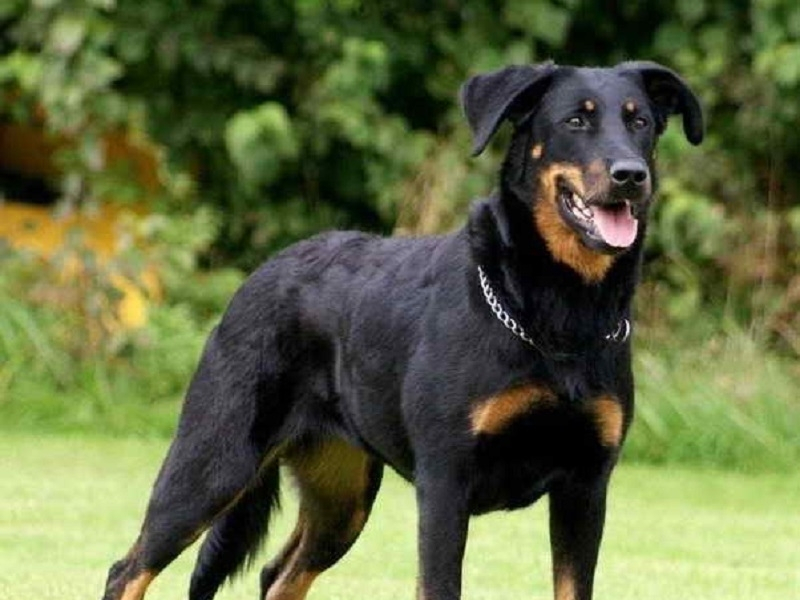
The German Shepherd Doberman Mix is not an expensive breed and doesn’t cost a lot to keep. The biggest cost associated with the Doberman Shepherd is potential veterinarian fees.
How Much is a German Shepherd Doberman Mix?
A German Shepherd Doberman Mix is $200 to $500. The price of a Doberman Shepherd changes depending on age, location, and sex. Female puppies tend to be more expensive than males as they can be used to make money from breeding.
The Doberman Shepherd should not be purchased from a puppy mill due to potential health concerns, even though it may seem cheaper.
How Much Does it Cost to Raise a Doberman Shepherd Mix?
The cost of feeding a Doberman Shepherd Mix is $80-$90 a month. Factoring in the cost of grooming, healthcare, and other expenses, you can expect to pay around $500 per year for your Doberman Shepherd.
Should You Get a Doberman German Shepherd Mix?
The Doberman German Shepherd Mix is a great breed, but it might not be suitable for everyone. It is important to do your research to ensure the breed is a good fit for you and your lifestyle.
Doberman Shepherds are Suitable for:
The Doberman Shepherd is suitable for active owners who enjoy going out on long walks. While it makes for an excellent companion, it is also best suited to working roles. It’s a great protector and well-suited for guarding property.
The Doberman Shepherd does not like to be alone, so owners need to spend a lot of time at home. The perfect environment is a large house in a rural location.
Doberman Shepherds are NOT Suitable for:
The Doberman Shepherd is an excellent family dog but is not always good around young children. Due to its large size and excessive energy, it isn’t suitable for apartment living.
You will need a large house with plenty of space outdoors to keep the Doberman Shepherd Mix happy.
On top of that, this breed isn’t the best choice for beginner dog owners. Due to its potentially aggressive nature and stubbornness, it can be difficult to train.
You might struggle to handle a Doberman Shepherd if you do not have experience with large guarding breeds. Further, if you work away from home all day, the Doberman Shepherd is not a good fit. It struggles with separation anxiety and can become destructive when left alone.
FAQs on Doberman German Shepherd Mix
What is a Doberman Shepherd mix?
A Doberman Shepherd mix is a crossbreed between a German Shepherd and a Doberman Pinscher. This hybrid combines the intelligence and loyalty of the German Shepherd with the strength and alertness of the Doberman, making them an excellent choice for families seeking a protective yet loving pet.
How big does a Doberman Shepherd get?
Adult Doberman Shepherds typically stand between 22 to 26 inches tall and weigh between 90-110 pounds. Females are usually slightly smaller than males. Their size is influenced by the traits of their German Shepherd and Doberman parents.
Are Doberman Shepherd mixes good family dogs?
Yes, Doberman Shepherds can be great family dogs. They are known for their loyalty and protective nature. However, they are best suited for families with older children due to their size and energy levels. Proper training and socialization are key to ensuring they are well-behaved family members.
How much exercise does a Doberman Shepherd need?
Doberman Shepherds require a significant amount of exercise, at least 90 minutes daily, due to their high energy levels. This should include walks, playtime, and other forms of physical activity to keep them healthy and happy.
What kind of training does a Doberman Shepherd need?
Doberman Shepherds need consistent, positive training starting from a young age. Due to their intelligence and sometimes stubborn nature, they respond well to firm but fair training methods. Ongoing training and socialization are important to manage their protective instincts and ensure they are well-adjusted.
How should a Doberman Shepherd be groomed?
Doberman Shepherds have a medium-length coat that requires regular brushing, about a few times a week. They also need occasional baths, regular nail trimming, and ear and dental care. Grooming is not only important for their appearance but also for their overall health and well-being.
A Loyal, Intelligent, and Energetic Hybrid
This breed flourishes in a dynamic environment, needing at least 90 minutes of exercise daily along with plenty of mental challenges to prevent boredom-related behaviors. Ideally, they belong in homes with spacious yards and are less suited for apartment living.
As family companions, they are incredibly dedicated, forming close bonds with their owners. I’ve observed they tend to do better in homes with older children, given their size and energy levels. Their combination of loyalty, energy, and intelligence makes them a truly remarkable and fulfilling companion for the right owner.

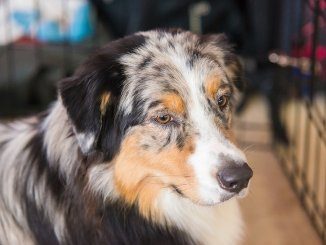

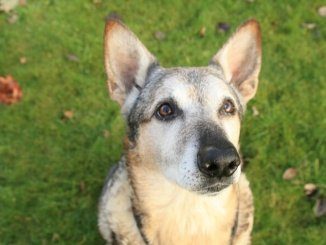
Be the first to comment